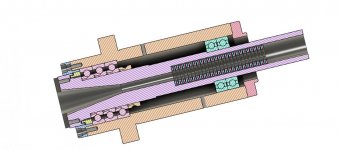So I got a BT30 spindle of the import kind similar to this:
ATC spindle BT30 Spindle CNC Milling Rounter Electric Spindle Motor 220V with Belt for BT30 Spring + Drawbar|motor 220v|220v motor|220v electric motor - AliExpress
The bearings were OK. But I desired to upgrade. So I go some matched angular contact bearings to replace the radial grooves it came with.
There are a set of 3 toward the spindle nose and a pair towards the rear.
I'm mostly asking about the rear bearings. The front bearings run true and everything is great. I didn't have the forethought to realize the rear bearings have no form of preload. The inner races butt against a shoulder on the shaft, but the outer races have no shoulder. There is a rear plate that bolts on, but is nearly 50 thou away. The bearings I used are a match pair of tandem (facing the same direction).
So my question is: do I need to make a shim to add some preload? My father (a retired mechanic, who is a smart guy) seems to think they will be fine to run free. I am wondering if the outer race will float away from the inner race.
Now I'm not so sure I should have left radial groove bearings as the rear pair.
I attached a cross section of the spindle someone else made. Be advised, there are threads and nuts to compress both sets of inner races.
Would welcome any thoughts on the subject.

ATC spindle BT30 Spindle CNC Milling Rounter Electric Spindle Motor 220V with Belt for BT30 Spring + Drawbar|motor 220v|220v motor|220v electric motor - AliExpress
The bearings were OK. But I desired to upgrade. So I go some matched angular contact bearings to replace the radial grooves it came with.
There are a set of 3 toward the spindle nose and a pair towards the rear.
I'm mostly asking about the rear bearings. The front bearings run true and everything is great. I didn't have the forethought to realize the rear bearings have no form of preload. The inner races butt against a shoulder on the shaft, but the outer races have no shoulder. There is a rear plate that bolts on, but is nearly 50 thou away. The bearings I used are a match pair of tandem (facing the same direction).
So my question is: do I need to make a shim to add some preload? My father (a retired mechanic, who is a smart guy) seems to think they will be fine to run free. I am wondering if the outer race will float away from the inner race.
Now I'm not so sure I should have left radial groove bearings as the rear pair.
I attached a cross section of the spindle someone else made. Be advised, there are threads and nuts to compress both sets of inner races.
Would welcome any thoughts on the subject.


